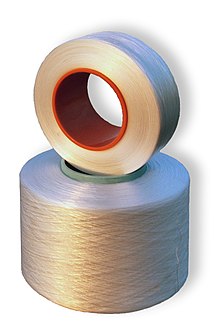Spandex
Spandex, Lycra, or elastane is a

Name
The name spandex, which is an anagram of the word "expands",[4] is the preferred name in North America. In continental Europe, it is referred to by variants of elastane.[a] It is primarily known as Lycra in the UK, Ireland, Portugal, Spain, Latin America, Australia, and New Zealand.
Brand names for spandex include Lycra (made by The Lycra Company, previously a division of DuPont Textiles and Interiors), Elaspan (The Lycra Company), Acepora (Taekwang Group), Creora (Hyosung), INVIYA (Indorama Corporation), ROICA and Dorlastan (Asahi Kasei), Linel (Fillattice),[5] and ESPA (Toyobo).
Production
Unlike many other synthetic fibers, spandex cannot be melt-processed because the polymer degrades upon melting. Spandex fibers are produced by several spinning technologies. Typically, a concentrated solution of the polymer is drawn through spinnerets at temperatures where the solvent evaporates.[6]

Spandex is mainly composed of a polyurea derived from the reaction of a diol and a diisocyanate. Two classes of spandex are defined by the "macrodiols". One class of macrodiols is the oligomer produced from tetrahydrofuran (i.e. polytetrahydrofuran). Another class of diols, the so-called ester diols, are oligomers derived from condensation of adipic acid and glycols. Spandex produced from the ester diols is more resilent photochemically and to chlorinated waters. Almost always, the diisocyanate is methylenebis(phenyl isocyanate). The key linking reaction is formation or the urea (aka urethane):
- ROH + OCNR' → ROC(O)NHR
The polyurea is usually treated with various diamines, which function as chain extenders.
Function
The exceptional elasticity of spandex fibers increases the clothing's pressure comfort, enhancing the ease of body movements. Pressure comfort is the response towards clothing by the human body's pressure receptors (mechanoreceptors present in skin sensory cells). The sensation response is affected mainly by the stretch, snug, loose, heavy, lightweight, soft, and stiff structure of the material.[7]
The elasticity and strength (stretching up to five times its length) of spandex has been incorporated into a wide range of garments, especially in skin-tight garments. A benefit of spandex is its significant strength and elasticity and its ability to return to the original shape after stretching and faster drying than ordinary fabrics. For clothing, spandex is usually mixed with cotton or polyester, and accounts for a small percentage of the final fabric, which therefore retains most of the look and feel of the other fibers. An estimated 80% of clothing sold in the United States contained spandex in 2010.[8]
Gallery
- Stretch material used in various sports
-
Aroad cyclist wearing compression garments
-
Ahurdlerin a uniform
History
The easy condensation of diols and diisocyanates was recognized in the 1930s as the result of work by Otto Bayer.[6] Fibers suitable for replacing nylon were not created from urethanes, but instead this theme led to a family of specialized elastic fabrics.
In the
In the early 1950s chemist
Lycra brand
To distinguish its brand of spandex fiber, DuPont chose the trade name Lycra (originally called Fiber K).[12] DuPont launched an extensive publicity campaign for its Lycra brand, taking advertisements and full-page ads in top women's magazines.[9] Audrey Hepburn helped catapult the brand on and off-screen during this time; models and actresses like Joan Collins and Ann-Margret followed Hepburn's aesthetic by posing in Lycra clothing for photo shoots and magazine covers.[13]
By the mid-1970s, with the emergence of the women's liberation movement, girdle sales began to drop as they came to be associated with anti-independence and emblematic of an era that was quickly passing away.[9] In response, DuPont marketed Lycra as the aerobic fitness movement emerged in the 1970s.[9] The association of Lycra with fitness had been established at the 1968 Winter Olympic Games, when the French ski team wore Lycra garments.[14] The fiber came to be especially popular in mid-thigh-length shorts worn by cyclists.[14]
By the 1980s, the fitness trend had reached its height in popularity and fashionistas began wearing shorts on the street.
In 2019, control of the Lycra Company was sold by Koch Industries to Shandong Ruyi.[16]
Environmental impact
Most clothes containing spandex are difficult to recycle.[17] Even a 5% inclusion of spandex will render the fabric incompatible with most mechanical recycling machines.
Notes
- ^ Including élasthanne (France), Elastan (Germany, Sweden), elastano (Spain), elastam (Italy), and elastaan (Netherlands)
References
- ^ ISBN 9780873552219.
- ^ ISBN 9781683306313.
- ^ ISBN 9780470508923.
- ISBN 9780135007594.
- ^ "Fillattice Stretches Its Reach Globally". Textile World. March 1, 2000. Retrieved December 22, 2021.
- ^ ISBN 978-3527306732.
- ISBN 9780857090645.
- ^ Marisa Penaloza (December 11, 2011). "Spandex Stretches To Meet U.S. Waistlines". NPR. Retrieved January 17, 2012.
- ^ ISBN 9780812206050
- ^ "Joseph c. Shivers to Receive The Olney Medal" (PDF). American Association of Textile Chemists and Colorists. August 1998. Archived from the original (PDF) on December 3, 2013. Retrieved November 26, 2018.
- ISBN 9781317402565.
- . Retrieved December 6, 2018.
- ^ Clark, Meaghan. "What Came First: The Yoga Pant Or The Skinny Jean?". Refinery29. Vice Media. Retrieved December 11, 2018.
- ^ a b "Lycra: a brief history". The Sydney Morning Herald. Archived from the original on November 17, 2021. Retrieved December 11, 2018.
- ^ a b "Spandex – Fashion, Costume, and Culture: Clothing, Headwear, Body Decorations, and Footwear through the Ages". Encyclopedia of Fashion. Retrieved December 11, 2018.
- ^ Kane Wu, Scott Murdoch (August 6, 2020). "'China's LVMH' Shandong Ruyi resists Lycra sale in favour of IPO amid debt crisis: sources". Reuters. Retrieved April 10, 2024.
- S2CID 43014321.
External links
- "What's That Stuff: Spandex" Chemical and Engineering News



